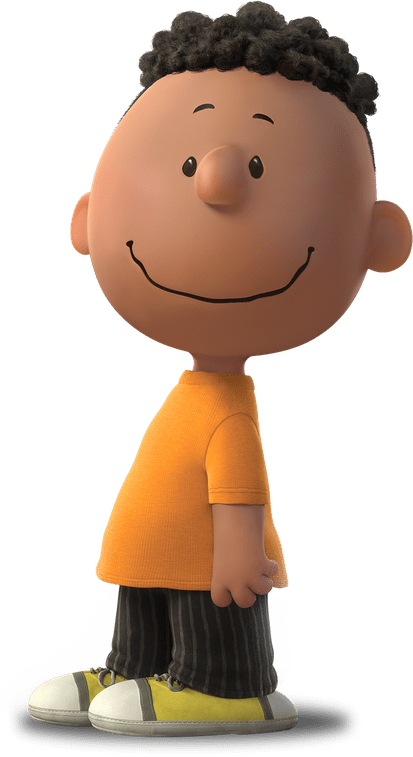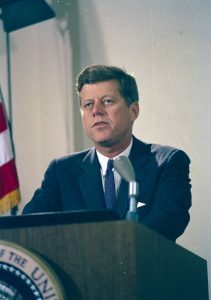Winner of the Spring 2019 StMU History Media Award for
Best Descriptive Article
Best Article in the Category of “Social History”
Many people are familiar with the lovable beagle Snoopy and the other members of Charles M. Schulz’s ‘Peanuts’ comics. The series revolves around Charlie Brown, his friends, and the famous beagle, Snoopy. While Snoopy lives in a fantasy world where he consistently engages in aerial battle with the WWI Red Baron, Charlie Brown must deal with much of life’s disappointments, ranging from receiving rocks in his Halloween candy bag to being tormented by Lucy van Pelt.1 Snoopy has become a household name; the character has even appeared in popular clothing brands such as Levi’s, Vans, and BAGGU. In addition, there are multiple locations around the globe where Charlie Brown and his friends are celebrated. For example, there are museums in Tokyo and California dedicated to both Snoopy and Charles M. Schulz himself, and there’s the famous amusement park, Knott’s Berry Farm, that would later make the Charlie Brown characters a part of their addition. No doubt, the ‘Peanuts’ characters are one of the most well-known cartoon icons. Much of their popularity began in the 1950s; however, the year 1968 was an especially interesting year for the ‘Peanuts’ gang. It was the year Schulz gave way to the comic’s first black character, and the year Franklin Armstrong became part of the ‘Peanuts’ family. Although a small act, Franklin’s debut became a big step in normalizing integration and it marked Schulz as one of the most influential cartoonists of all time.2
The year 1968 was a big year not only for Schulz, but it was also a big year for the African American population, the Civil Rights movement, and much of the United States. On April 4 of that same year, Martin Luther King Jr. was assassinated in Memphis, Tennessee. His death was met with outrage, and it sparked multiple riots and protests throughout the nation. A few months later, Robert F. Kennedy, an advocate for equality and civil rights, was also assassinated. Just a few years prior to King’s and Kennedy’s death, there was the Little Rock Nine who made one of the first attempts towards desegregation in public white schools. As many had already predicted, the Little Rock Nine were not welcomed by white students, and were instead greeted through physical and verbal abuse.3 It’s hard to say the United States was making much progress towards equal rights and desegregation, but it was still making some attempts. One of these attempts was made by Schulz and a retired teacher who resided in Southern California, Harriet Glickman.4
Harriet Glickman was both a teacher and a mother of three children, and, in the wake of Martin Luther King Jr.’s assassination, felt the need to spark some sort of hope during such a dark and rough time. Glickman explains her motive in an interview, “I was thinking about Dr. King, and about having lived through so many years of struggles and the racism and the [divisiveness] that existed.”5 Having children of her own, Glickman recognized how powerful and impactful comics were at the time. She realized, however, that many young comic fans had yet to see any type of diversity in any of the comic strips. Glickman said, “And my feeling at the time was that I realized that black kids and white kids never saw themselves [depicted] together in the classroom.”6 With that in mind, Glickman made it a priority to pen letters to several cartoonists; she requested that they offer images of integration and diversity in their comic strips, and she suggested that they include a colored individual as one of their main characters.7

Glickman first got in touch with the author of the “Mary Worth” comic series, Allen Saunders. Both Saunders and his artist, Ken Ernst, thought that the idea of integration would be nice. However, they feared being dropped from the syndicate, telling Glickman that “it is still impossible to put a Negro in a role of high professional importance and have the reader accept it as valid…He too would be hostile and try to eliminate our product.”8 Unfortunately, Saunders and Ernst walked away from Glickman’s proposal. But Schulz wrote back to Glickman expressing interest in the idea. However, like Saunders and Ernst, he was also very hesitant in moving forward with Glickman’s vision, primarily because he did not want to integrate characters in the comics out of fear that he would sound condescending to the African American race. Glickman acted quickly upon Schulz’s response, telling him she thought it would be a good idea to consult with fellow African American friends and ask for their opinions on integration in the series. She turned to friends Kenneth Kelly and Monica Gunning; they themselves wrote to Schulz encouraging him to move forward with Glickman’s idea. In contrast to what Glickman originally visualized, Kelly expressed that it would be better to add a character of color who would merely stand in the background. In this manner, integration would be introduced slowly and gradually, instead of automatically pushing it to the front line. Shortly thereafter, Schulz wrote back to Glickman with his response, telling her that he had received Kelly and Gunning’s feedback, and he hinted that she would very much be amused with his next comic strip.9

Shortly before the release of his next comic strip, which featured Franklin, Schulz was asked by the head of the United Feature Syndicate if he was sure he wanted the story to be released. Schulz responded with more confidence than ever, telling him they could either release the strip as is or else he would quit. It’s important to know that the ‘Peanuts’ series had already gathered a large fanbase and was very popular at this time, having millions of fans and readers globally. The syndicate had no choice; they had to release the story, otherwise they would risk giving up an already famous and influential cartoonist.10
Schulz released his latest comic strip on July 31, 1968, and it was the day Franklin Armstrong made his debut in the series. Almost fifty years ago, Charlie Brown lost sight of his beach ball and it was later returned to him by the series’ first member of color. Following their encounter, the two friends returned to the seashore and built a sandcastle together.11

Franklin’s debut broke racial barriers and was met with both praise and criticism, and much of the latter would come from the South. Many editors from the South sent messages to Schulz, and expressed that they did not want to see colored children interacting with white children, claiming that schools in the South were already going through a desegregation process. The process itself was already too heavy and controversial in the South, and seeing characters like Franklin in the newspaper was merely distasteful to Southerners.12
While some complained about the comic series introducing a member of color, others complained that Franklin was too bland and boring of a character in comparison to the rest of the ‘Peanuts’ gang. They argued that Franklin was ‘too perfect’ and did not have a defining characteristic much like how Charlie Brown is known for being reluctant and Lucy for being a bit snooty. Instead, Franklin was intelligent, very athletic, and overall, he was a good person. Despite his debut making a groundbreaking statement, he didn’t seem to meet the expectations of many. However, what many forget is that Schulz feared sounding patronizing or condescending in his creation of Franklin, and therefore had to be careful in how he characterized him.13
Regardless of the criticism Schulz received, the comic strip was successful in giving the African American population some representation and a place in society. This particularly rang true for Robb Armstrong, who was just six years old at the time of Franklin’s debut. Franklin’s appearance in the comic series was remarkable and touching for Armstrong, who had told his mother he wanted to be a cartoonist. He later became the creator of both Fearless: A Cartoonist’s Guide to Life and Jumpstart and even met Schulz after having sent the latter a comic strip of his own.14 A few year later, Schulz called Armstrong to ask if Franklin could bear the latter’s last name, having realized the character was only known as “Franklin.”15
Recently, in 2018, the ‘Peanuts’ series was met with outrage and was accused of racism because of a particular scene in the movie “A Charlie Brown Thanksgiving.” The scene depicted Charlie Brown and his friends sitting around a table, with most of them sitting on one side of the table and Franklin sitting by his lonesome on the other side. Many viewers took this scene as a hint towards segregation. This backlash in itself is ironic, as the reason Franklin was introduced to begin with was to fight back against racism and to normalize integration, especially in schools. Without Glickman’s impulse on making a statement and Schulz’s confidence in his influence as a cartoonist, Franklin may not have ever existed to begin with. The people of today may point fingers at the series all they want, but no one can deny Franklin’s bittersweet backstory, Glickman and Schulz’s good intentions, nor the impact it would have on the many readers living in such a despairing time.
- Britannica, 2009, s.v. “Peanuts,” by Michael Ray. ↵
- Stan Friedman, “50 Years Ago, Teacher Spurred Integration in ‘Peanuts’ Strip,” COV (blog), August 1, 2018, https://covenantcompanion.com/2018/08/01/50-years-ago-teacher-spurred-integration-in-peanuts-strip/. ↵
- Ha Thu-Huong, “The Sweet Story Behind Peanuts’ Groundbreaking First Black Character,” Quartz, December 11, 2015, https://qz.com/571393/the-sweet-story-behind-peanuts-groundbreaking-first-black-character/. ↵
- Kamp David, “Guess Who’s Coming to ‘Peanuts,’” The New York Times, January 13, 2018, https://www.nytimes.com/2018/01/13/opinion/sunday/peanuts-franklin-charlie-brown.html. ↵
- Kavna Michael, “Franklin Integrated ‘Peanuts’ 47 Years Ago Today. Here’s How a Teacher Changed Comics History,” The Washington Post, July 31, 2015, https://www.washingtonpost.com/news/comic-riffs/wp/2015/07/31/franklin-integrated-peanuts-47-years-ago-today-heres-how-a-teacher-changed-comics-history/?noredirect=on&utm_term=.281dcb22ddaf. ↵
- Kavna Michael, “Franklin Integrated ‘Peanuts’ 47 Years Ago Today. Here’s How a Teacher Changed Comics History,” The Washington Post, July 31, 2015, https://www.washingtonpost.com/news/comic-riffs/wp/2015/07/31/franklin-integrated-peanuts-47-years-ago-today-heres-how-a-teacher-changed-comics-history/?noredirect=on&utm_term=.281dcb22ddaf. ↵
- Kavna Michael, “Franklin Integrated ‘Peanuts’ 47 Years Ago Today. Here’s How a Teacher Changed Comics History,” The Washington Post, July 31, 2015, https://www.washingtonpost.com/news/comic-riffs/wp/2015/07/31/franklin-integrated-peanuts-47-years-ago-today-heres-how-a-teacher-changed-comics-history/?noredirect=on&utm_term=.281dcb22ddaf. ↵
- Tom Heintjes, “Crossing the Color Line (in Black in White): Franklin in “Peanuts”,” Hogan’s Alley, July 31, 2013, http://cartoonician.com/crossing-the-color-line-in-black-and-white-franklin-in-peanuts/. ↵
- Wong Kevin, “Franklin Broke Peanuts’ Color Barrier In The Least Interesting Way Possible,” Kotaku (blog), July 31, 2018, https://kotaku.com/franklin-broke-peanuts-color-barrier-in-the-least-inter-1793843085. ↵
- Kavna Michael, “Franklin Integrated ‘Peanuts’ 47 Years Ago Today. Here’s How a Teacher Changed Comics History,” The Washington Post, July 31, 2015, https://www.washingtonpost.com/news/comic-riffs/wp/2015/07/31/franklin-integrated-peanuts-47-years-ago-today-heres-how-a-teacher-changed-comics-history/?noredirect=on&utm_term=.281dcb22ddaf. ↵
- Cecilia Lei and James Delahoussaye, “‘Peanuts’ First Black Character Franklin Turns 50,”NPR, July 29, 2018, http://www.npr.org/2018/07/29/633544308/peanuts-character-franklin-turns-50. ↵
- Wong Kevin, “Franklin Broke Peanuts’ Color Barrier In The Least Interesting Way Possible,” Kotaku,July 31, 2018, https://kotaku.com/franklin-broke-peanuts-color-barrier-in-the-least-inter-1793843085. ↵
- Wong Kevin, “Franklin Broke Peanuts’ Color Barrier In The Least Interesting Way Possible,” Kotaku,July 31, 2018, https://kotaku.com/franklin-broke-peanuts-color-barrier-in-the-least-inter-1793843085. ↵
- Axelrod Jim, “The Surprising Story behind Franklin, the First Black “Peanuts” Character,” CBS News, August 02, 2018, http://www.cbsnews.com/news/the-surprising-story-behind-franklin-the-first-black-peanuts-character/. ↵
- Cecilia Lei and James Delahoussaye, “‘Peanuts’ First Black Character Franklin Turns 50,”NPR, July 29, 2018, http://www.npr.org/2018/07/29/633544308/peanuts-character-franklin-turns-50. ↵



97 comments
Thomas Fraire
I really enjoyed this article, it reminds me of my childhood. I loved watching the shows growing up and reading the comics in the paper. It is really cool to see a cartoon show/comic strip being progressive in a time where it could have received backlash. This story was unique and it was cool to see how different it is compared to others in congrats on your nomination!
Christopher Hohman
Nice article. I love the Charlie Brown characters especially snoopy. His duels with the red baron are legendary. I always enjoy watching the Christmas special with my family during the holidays. It was quite a monumental decision to create a character of color in the series. It must have been quite something for Franklin to be part of what was once an all white group. I do not understand why some people were opposed to the idea, but then again I did not live during the 1960s. It is also a little silly to say that Franklin’s creators should have gone farther because in the 1960s just putting Franklin with the rest of the crew was enough. He does not have to live up to some of the black characters that became popular later.
Danniella Villarreal
The Peanuts cartoons are my favorite part of certain holidays because I would always look forward to watching the specials for Halloween and Thanksgiving and Christmas. I did not know much about the backstory of Franklin but now I do. Overall I loved the article and it taught me a lot!
Ruben Basaldu
The Peanuts cartoons are my favorite part of certain holidays because I would always look forward to watching the specials for Halloween and Thanksgiving. There was a lot of information in this article that I did not know about so reading this article was very informative. I did not know much about the backstory of Franklin but now I do. I think that the introduction of Franklin was a smart move because it helped change the way people view those of color.
Mariah Cavanaugh
I think Harriet Glickman’s statement on the lack of representation is just as accurate today as it was in 1968. We are just getting to a point where black women are gracing the cover of popular magazines. Giving a child the ability to see themselves represented has the potential to open their mind to a world of possibilities. This was a beautifully written and heartwarming story, good job!
Christopher Metta Bexar
People of color have been in the public media for years. In the early 1990s the Album of the Year at the Grammys went to an African American female singing a collection of standards made famous by her father in the 1940s and 50s. The Oscar for best supporting actress of 1939 went to a woman of color (for a role some might find degrading).
But I am of the age that I remember Franklin’s debut. He wasn’t a “look at me” freak of nature like Kanye West. Just a new cast member of a successful strip brought in by a man who had enough fans that it had to be allowed. Change is best when it happens naturally. Charles Shultz proved that.
Nadia Carrasco
This was a great article! My little brother has always loved The Peanuts but I never got into it as a child. The article does a great job at explaining how they tied in historic events that were happening during this time into the cartoon. Integrating diversity into this cartoon was a smart thing to do although people at the time did not respond well. Overall I loved the article and it taught me a lot!
Amariz Puerta
Love love love the featured photo it caught my attention right away. I always remembered watching a charlie brown thanksgiving at school every year. I also remember watching The Peanuts but never fully understood the reason behind the character development. I loved this article it really showed why they created him and how they introduced a character of color. Highly recommend this article to anyone, good work!!
Mia Morales
I grew up watching The Peanuts cartoons and always felt a piece of my childhood in them. I loved this article and what it represented. Unlike those who thought this character was “distasteful” I loved that they decided to include more diverse characters. As a child it is important for minorities to see characters that resemble themselves.
Sharriah Martinez
This was a great article. I didnt realize until reading this article just how much i lacked in knowledge about The Peanuts cartoon. I have seen many holiday specials and though I knew a lot about them but i definitely lacked the actual background of the characters. I definitely did not that Franklin was purposely introduced as a character of color. I feel like that is so important and it is amazing that that was noticed at this time. I had no idea that Franklin was even added to the show i thought he was a part of the original cast. It is sad reading about how they had to tone down his character because of assumptions based on race.
Tyler Reynolds
Decent introduction. I did not know that the “Peanuts” comic strip was famous and well-known throughout the world. I had never known that Franklin wasn’t an original character in the series. This story reminds me somewhat of the Calvin and Hobbes comic strip which I loved as a child. The Calvin and Hobbes comic strip would see it’s fair share of one time stand alone characters but without the political baggage. That being said, the series itself had some political aspects as the main character, Calvin, was very concerned for the environment and somewhat cynical at the current state of the world.